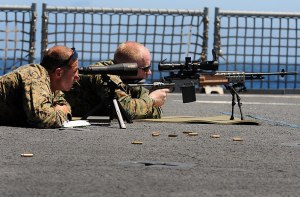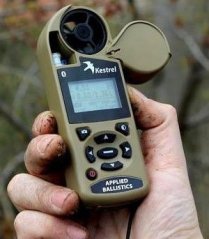There’s nothing quite like hearing the distinctive ring of hitting a target at a longer distance. It’s a great feeling – and although accurate shots are certainly doable for the average shooter inside of 200 or 300 yards, beyond that you’ll need the skill and the tools necessary to meet the added challenge.
Aside from being both fun and rewarding, long distance rifle shooting is a great addition to any shooter’s skill set. There’s a certain mental, physical and technical discipline required, in addition to a good working knowledge of ballistics and environmental factors that will always serve you well in the long run. Ultimately, this is what makes it appealing to those who want to go to the next level.
There are a number of ways to define and categorize what long range shooting means exactly, but generally short range would be considered to be less than 300 yds., long range between 300 – 1200 yds. and extra-long being beyond a mile. Shorter range shooting typically requires very little compensation or ‘math’ to account for drop or wind deflection. Anything longer will need some attention and corrections to offset the factors affecting your point of impact.
In this edition we’ll be talking guns and gear, with technique to follow at a later date.
Getting Yourself Set Up
There is no shortage of equipment available on the market that will help to optimize your performance at distance. Some of it is certainly really high-end and pricey, but there are many reasonable options out here. You don’t need to break-the-bank – just get the best that you can afford when putting together your ‘system’.
Rifle
Obviously, your choice of rifle is going to make a big difference with your overall performance. You won’t need to overdo it however with regard to sophistication and expense – just keep things in perspective for how you’re going to be using it. A precision rifle typically is designed and built to a higher standard than a run-of-the-mill model, with features that will help at longer distances.
won’t need to overdo it however with regard to sophistication and expense – just keep things in perspective for how you’re going to be using it. A precision rifle typically is designed and built to a higher standard than a run-of-the-mill model, with features that will help at longer distances.
The actual type isn’t super critical (most people have their preferences), but it does need to perform consistently and be capable of shooting the right caliber for longer ranges. It should have a decent trigger and a rail for higher-end optics. These guns also tend to be heavier to help reduce the effects of recoil.
Optics
This is not meant in any way to be a comprehensive guide to the science of scopes and calculations (that’s for another edition), but the bottom-line is that a higher quality scope and mount will serve you much better than lower-end models. You’ll definitely want the sharpest and clearest picture possible in these cases.
Many tactical scopes will come equipped with a mil-dot reticle and a target turret to help account for both drop and wind conditions. The ability to dial-in adjustments for MOA (Minute of Angle) is very helpful when determining angles or distance. Working with a spotter can also be beneficial.
Bipod
Be sure to utilize a good quality bipod that is compatible with shooting prone. These are often adjustable from 6 to 9 in. and can be of the fixed or swivel variety.
Ammo
For long range hunting or target shooting, the caliber that we choose should have a high BC (Ballistic Coefficient) number for the best results. The actual grain count may vary, but it’s the aerodynamics of the projectile that makes the difference. Specific bullet shapes have less drag and are more effective at overcoming air resistance. A higher BC provides for less drop and deflection based on the muzzle velocity and the environmental conditions. The number is also essential for calculating the trajectory of your shots and it can typically be found printed on the box or on the manufacturer’s website.
When making your decision from the many options out there, it is generally understood that match-grade ammo is the way to go for consistency and accuracy at longer distances. Everyone will develop their preferences for performance, but you have to consider cost, availability and recoil as well.
Cheek Pad
Utilizing a cheek rest, riser or quality butt cuff is a good idea to help maintain comfort and promote consistency for your shots. It’s important to position your eye properly behind the scope and create a natural-feeling cheek weld for best results. Evenly distributing the weight of your head and avoiding awkward positions and neck strain help to keep you properly aligned and relaxed.
Technology
The electronic gadgets available today that help measure, calculate and provide firing solutions for  long range shooting are really a must for anyone serious about success (and not wasting ammo). Some can be tricky to set-up and use correctly and you still have to apply some manual skill to make it all work, but they are great tools that absolutely help to give you the best, calculated chance of hitting your target. You may actually still have to take some notes to track results as reference while you’re shooting, but it’s all part of the process. Depending on their features, these items can work individually or they can be used together to get the most out of the data provided.
long range shooting are really a must for anyone serious about success (and not wasting ammo). Some can be tricky to set-up and use correctly and you still have to apply some manual skill to make it all work, but they are great tools that absolutely help to give you the best, calculated chance of hitting your target. You may actually still have to take some notes to track results as reference while you’re shooting, but it’s all part of the process. Depending on their features, these items can work individually or they can be used together to get the most out of the data provided.
Rangefinder
These units are not all created equal. Be sure to source a good quality version for precise distancing and added features to account for elements such as slope angle correction. Models with low beam divergence technology will also provide greater accuracy.
Wind Meter
One of the biggest challenges when attempting a long-range shot is compensating for wind deflection and determining your wind hold. Aside from the traditional method of wetting your finger and holding it up in the air, the use of a good multi-feature wind meter is a must if you want to accurately measure wind speed and direction. Without this information, your ability to figure the angle and level of your hold will be limited.
Ballistic Calculators & Phone Apps
These are great at tying everything together and providing even more data to help you make those longer shots. They essentially convert environmental, target and ballistic information into practical trajectory corrections that take the guesswork out of shooting. Depending on which brand and type you use, there is almost no end to the potential, especially when you’re able to integrate devices and remote station data through Bluetooth.
While the science of long-range shooting can seem intimidating, especially to beginners, most people see reasonable success if they’re able to embrace the process and approach it methodically. With the right mindset and the right equipment, it’s all possible (and a lot of fun).
Sign up for K-Var’s weekly newsletter and discounts here.

Leave a Reply